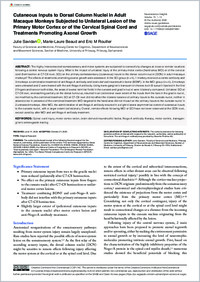Cutaneous inputs to dorsal column nuclei in adult macaque monkeys subjected to unilateral lesion of the primary motor cortex or of the cervical spinal cord and treatments promoting axonal growth
- Savidan, Julie Faculty of Sciences and Medicine, Fribourg Centre for Cognition, Department of Neurosciences and Movement Sciences, Section of Medicine, University of Fribourg, Fribourg, Switzerland
- Beaud, Marie-Laure Faculty of Sciences and Medicine, Fribourg Centre for Cognition, Department of Neurosciences and Movement Sciences, Section of Medicine, University of Fribourg, Fribourg, Switzerland
- Rouiller, Eric M. Faculty of Sciences and Medicine, Fribourg Centre for Cognition, Department of Neurosciences and Movement Sciences, Section of Medicine, University of Fribourg, Fribourg, Switzerland
- 17.11.2020
Published in:
- Neuroscience Insights. - 2020, vol. 15, p. 2633105520973991
English
The highly interconnected somatosensory and motor systems are subjected to connectivity changes at close or remote locations following a central nervous system injury. What is the impact of unilateral injury of the primary motor cortex (hand area; MCI) or of the cervical cord (hemisection at C7-C8 level; SCI) on the primary somatosensory (cutaneous) inputs to the dorsal column nuclei (DCN) in adult macaque monkeys? The effects of treatments promoting axonal growth were assessed. In the SCI group (n = 4), 1 monkey received a control antibody and 3 monkeys a combination treatment of anti-Nogo-A antibody and brain-derived neurotrophic factor (BDNF). In the MCI group (n = 4), 2 monkeys were untreated and 2 were treated with the anti-Nogo-A antibody. Using trans-ganglionic transport of cholera toxin B subunit injected in the first 2 fingers and toes on both sides, the areas of axonal terminal fields in the cuneate and gracile nuclei were bilaterally compared. Unilateral SCI at C7-C8 level, encroaching partially on the dorsal funiculus, resulted in an ipsilesional lower extent of the inputs from the toes in the gracile nuclei, not modified by the combined treatment. SCI at C7-C8 level did not affect the bilateral balance of primary inputs to the cuneate nuclei, neither in absence nor in presence of the combined treatment. MCI targeted to the hand area did not impact on the primary inputs to the cuneate nuclei in 2 untreated monkeys. After MCI, the administration of anti-Nogo-A antibody resulted in a slight bilateral asymmetrical extent of cutaneous inputs to the cuneate nuclei, with a larger extent ipsilesionally. Overall, remote effects following MCI or SCI have not been observed at the DCN level, except possibly after MCI and anti-Nogo-A antibody treatment.
- Faculty
- Faculté des sciences et de médecine
- Department
- Département de Médecine
- Language
-
- English
- Classification
- Biological sciences
- License
-
License undefined
- Identifiers
-
- RERO DOC 329931
- DOI 10.1177/2633105520973991
- Persistent URL
- https://folia.unifr.ch/unifr/documents/309076
Statistics
Document views: 152
File downloads:
- pdf: 164
